Lavender hair at Le Meridien Angkor Wat, Siem Reap! Luxury hotel & restaurants closest to Cambodian temples.
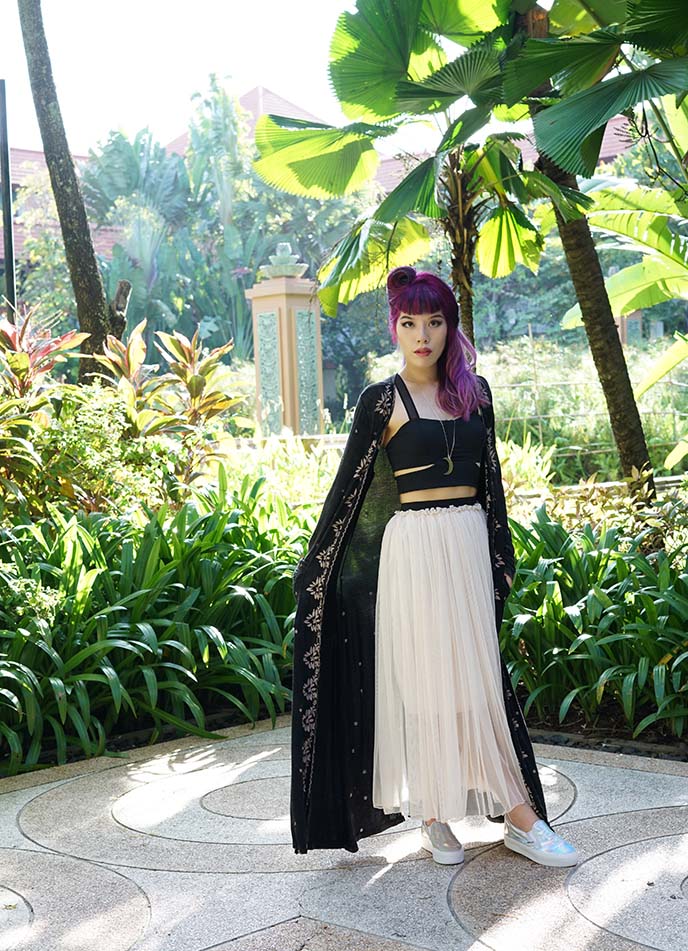
Cambodia has fascinated me for ages. I dreamed of exploring the mysterious temple of Angkor Wat, and experiencing the warm culture I’d heard so much about.
Finally, I got to travel here thanks to the new HK Express flight route! This airline has low-cost fares from Hong Kong directly to Siem Reap, where the temples are found.
At Le Méridien Angkor hotel, I got a grand introduction to Cambodian hospitality. Passionfruit, smiling elephant statues, bodhi trees… Let’s start the journey right here.

I got quite a few comments on my Instagram (@lacarmina) about this outfit of the day — and new lavender hair color! I’m wearing a Bohemian kimono by Pylo.
The label name stands for “Pursue Your Life’s Obsessions” — a message I can get behind, as it sums ups my travel approach. Pylo has a fantastic selection of Gothic-Gypsy fashion, including this crescent moon necklace and black lace bell-bottoms.

OUTFIT DETAILS: Michi top † White tulle skirt † Linda Farrow sunglasses † Metallic sneakers
I’m wearing this exact crop top by Michi, a designer activewear company. Michi makes all types of dark sports fashion such as this top with sheer panels, and colorblocked sports bra (currently on major sale — more below).
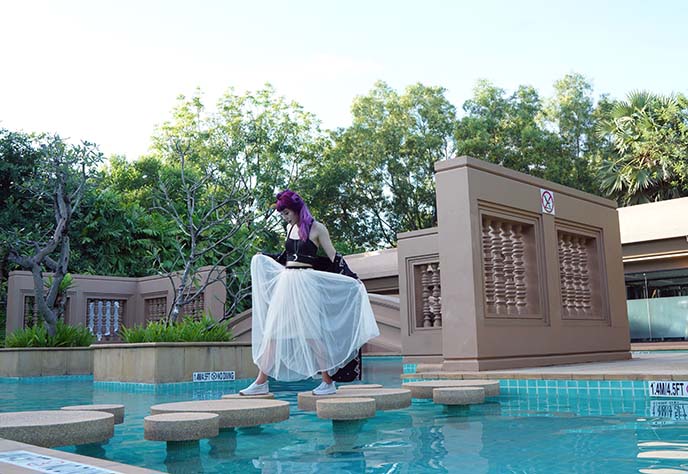
I paired it with a long white tulle skirt that made me feel like a ballet dancer. Here’s a similar skirt with black hearts on it — so pretty.

We loved the artistic feeling of Le Meridien Angkor, a Starwood property. The hotel is modern design meets classic Khmer, especially the lush gardens dotted with Hindu statues.
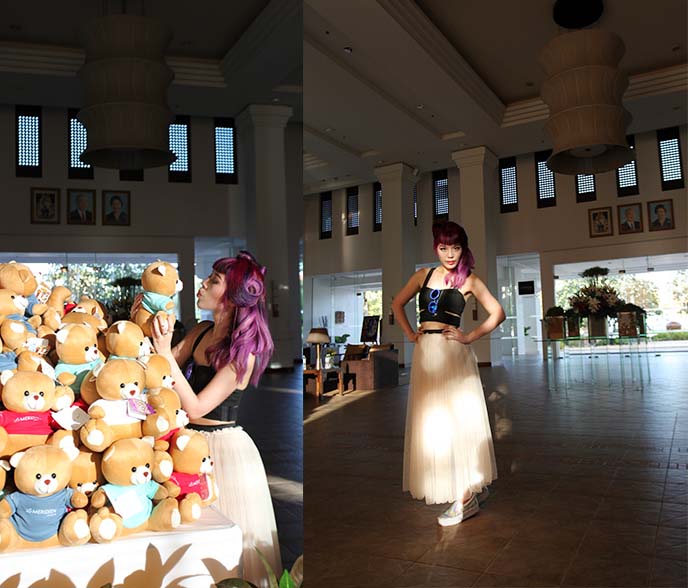
It was remarkably easy to get to Siem Reap from Hong Kong. We flew direct on HK Express and the trip only took 2.5 hours. Le Meridien sent a van to the airport to pick us up, and the drive to the hotel was a short 15 minutes.
From the minute we walked into the spacious lobby, we knew that this would be a peaceful stay. I liked the dramatic Cambodian lanterns, and stuffed bears for charity.
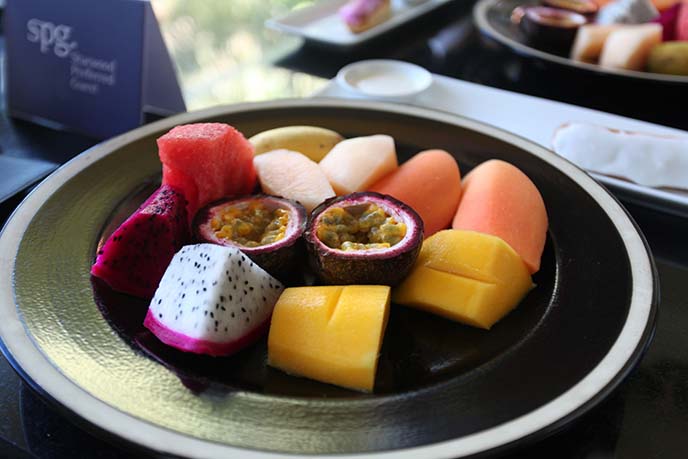
After a flight, it’s a relief to munch on fresh fruit. I discovered a new “passion for passionfruit,” and also couldn’t stop eating their fresh baked eclairs and croissants.

The staff of Le Meridien Angkor comes from international backgrounds, and they went above and beyond to make us feel at home. Director of marketing Dennis arranged a private temple tour for us, and helped us find out more about Buddhist yantra tattooing (where a monk performs a blessing).
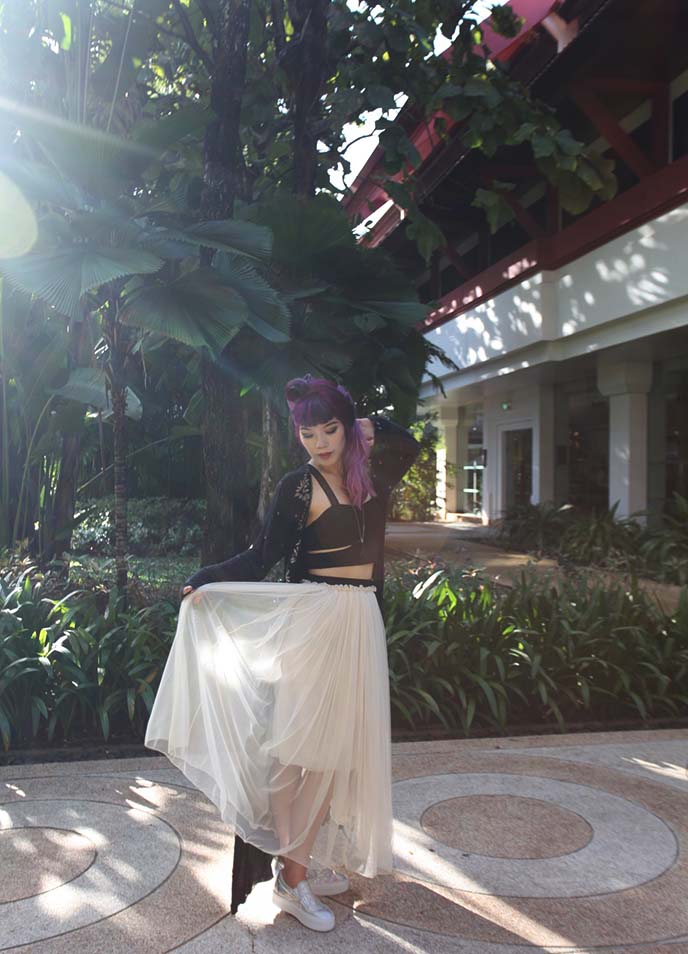
We enjoyed strolling in the hotel’s beautiful tropical gardens. At night, the rows of trees light up.
My witchy-wizard outfit — rings, moon necklace, long boho robe — are all from Pylo.

Water flows from the trunks of Ganesha, the elephant-headed Hindu god, in this courtyard fountain.

Cambodia is humid year round, and there can be mosquitoes — so I wore this Michi crop top, and loose layers over it.

We all had spacious bedrooms, with a deep bathtub and classic wood shutters. I got to catch up on work using their fast WiFi, while taking in a view of the pool and gardens.

My friend John Skeleton and I appreciated the location of Le Meridien — it’s as close as you can stay to the temples. The famous Angkor Wat is less than a 10 minute drive away.
(Address: Vithei Khum Svay Dang Kum, Charles De Gaulle, Krong Siem Reap 17259, Cambodia)
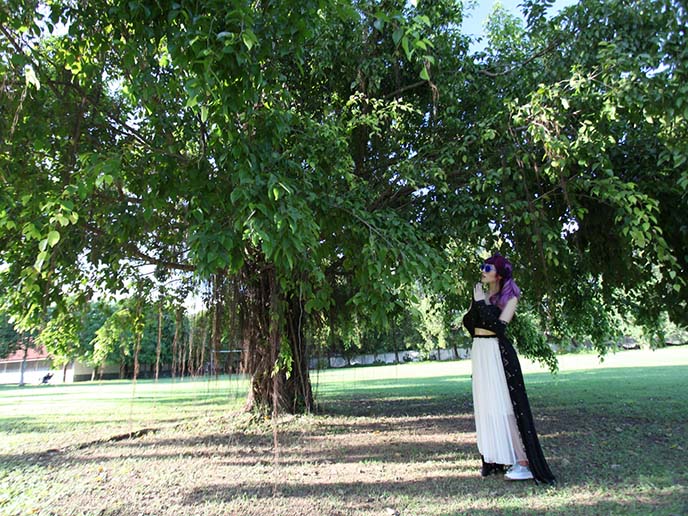
We loved how we could go to see the sunrise, and then easily come back for coffee and breakfast. Le Meridien Angkor was also located naer the historic Siem Reap district, night market, Pub Street and other attractions (I’ll show you in an upcoming post.)
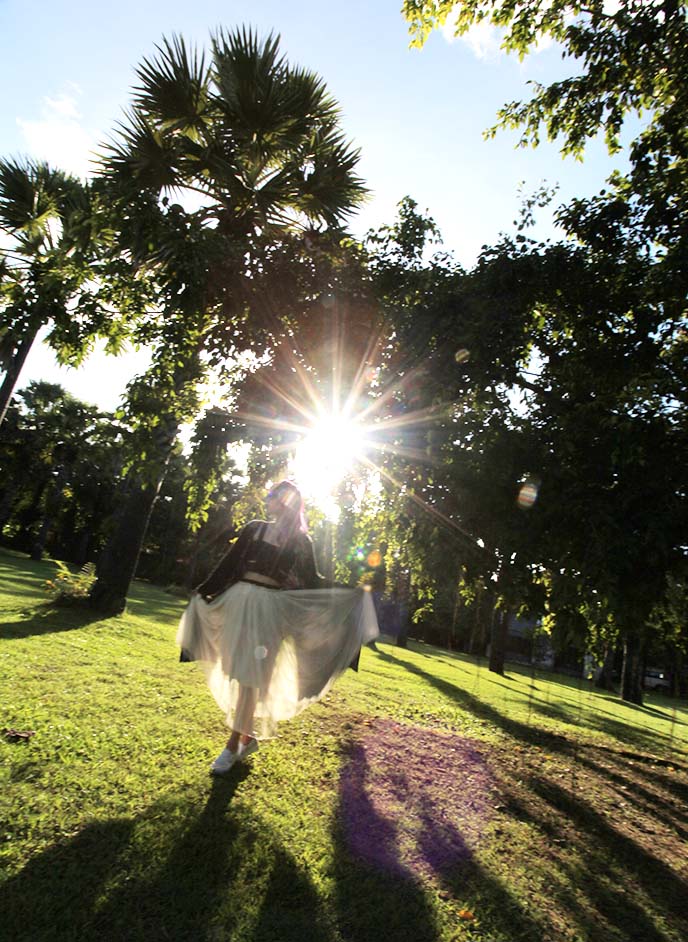
Trekking around Angkor Wat was a bit draining, especially with the humidity. We were glad we could always pop back into to the hotel to pick up equipment, shower and change our clothes.
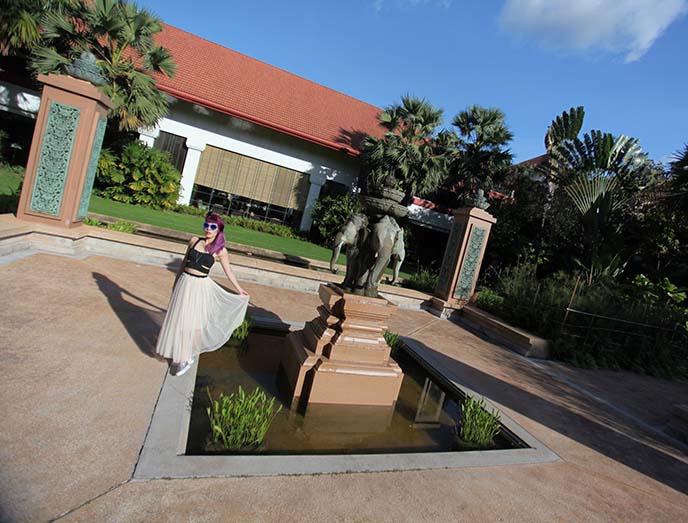
Le Meridien felt like a temple itself, with blossoming lotuses and Khmer-style pools.

(Wearing Pylo stacked silver rings, which come in mystical shapes).

I’ve wanted to dye my hair lavender for a while, and did it before this trip. My new haircolor happened to match these floating lotuses!
My stylist, Stephanie Hoy of Stratosphere Hair, did a purple light-to-dark ombre fade with Bettie Page short curved bangs. She twisted front sections into pin curls, for a retro explorer feel.

John went for a dip in the stunning outdoor swimming pool. It has a Tomb Raider feeling (appropriate, since the movie was shot at Ta Prohm temple).

I have so many photos from our Angkor Wat excursion to share with you next.

(Photography by Sniper Chau and Ken Yuen — and video coming soon too.)
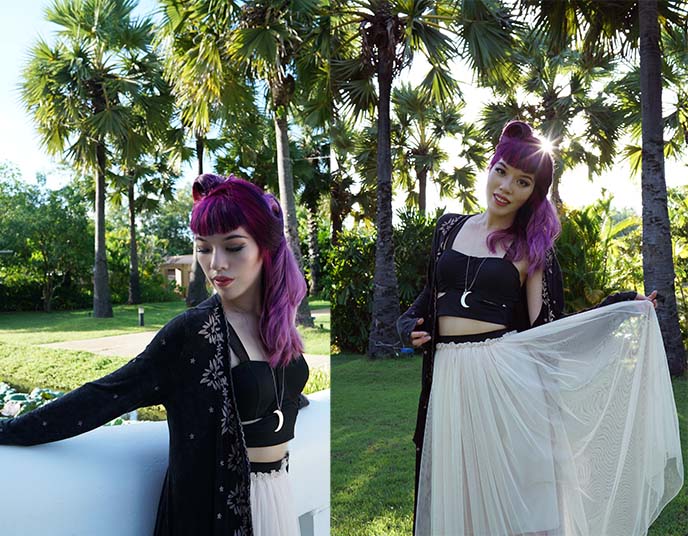
Thanks to Pylo for the bohemian-wizard fashion, which made me feel a bit like a Goth Sailor Moon.

I wore metallic, shiny creepers from Hong Kong — they are similar to these Acne sneakers.
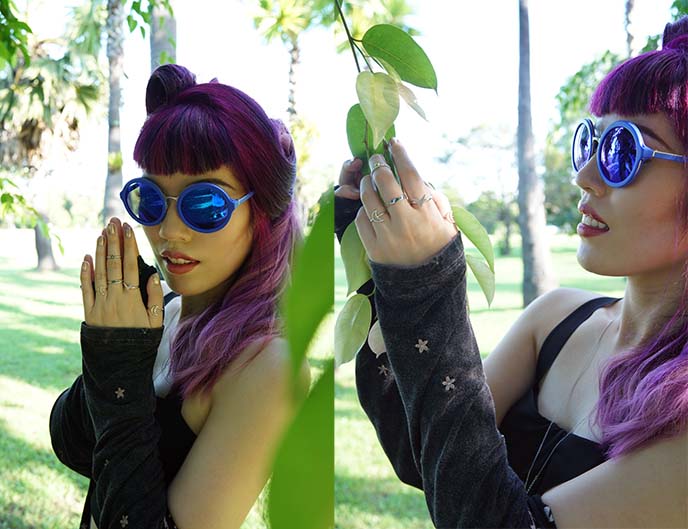
My round blue sunglasses are by Linda Farrow. She has a marvelous collection of cat eye sunglasses.
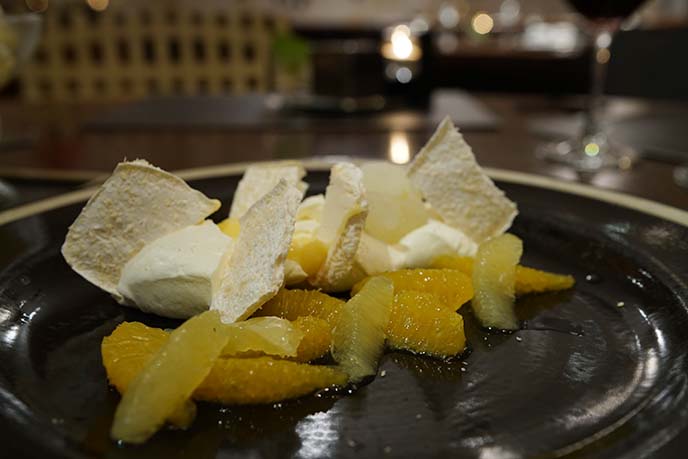
I leave you with a glimpse of the outstanding meals we had at Le Meridien Angkor! I’m still thinking about the Khmer pumpkin curry and spiced salads we had at their Cambodian Angkor Royal Café, and my daily breakfasts of passionfruit and yogurt.

However, our most memorable dinner was at l’Angelo Italian restaurant, headed by French chef Nicolas Rouleau. He served us the best pastas and Italian dishes I’ve had all year, along with an impressive selection of wines and cocktails.

At l’Angelo, traditional Italian recipes get modern, French touches. I ate up every last bite of this balsamic risotto with duck breast and parmesan.
The osso bucco, eggplant parmigiana, and spiced penne were also masterfully prepared.

We enjoyed the relaxed, contemporary look of the dining space. And how was dessert? The photos speak for themselves — fresh, tangy, inventive.

If you have limited time in Siem Reap, it’s especially worth staying at Le Méridien Angkor. This oasis is conveniently located by the temples, and you can enjoy local food, spa and culture right inside.

A curtsy to Ganesha, and to the hotel staff for making our stay an absolute pleasure. Coming up next — my travel diary of Angkor Wat!
What do you think of Cambodia so far? Did you enjoy my Outfit of the Day?

OUTFIT DETAILS: Michi top † Tulle skirt † Linda Farrow sunglasses † Metallic sneakers
SHARE & COMMENT
A Cooking Boat Cruise of Ha Long Bay! Sailing to Halong caves with Vietnam Food Tour.
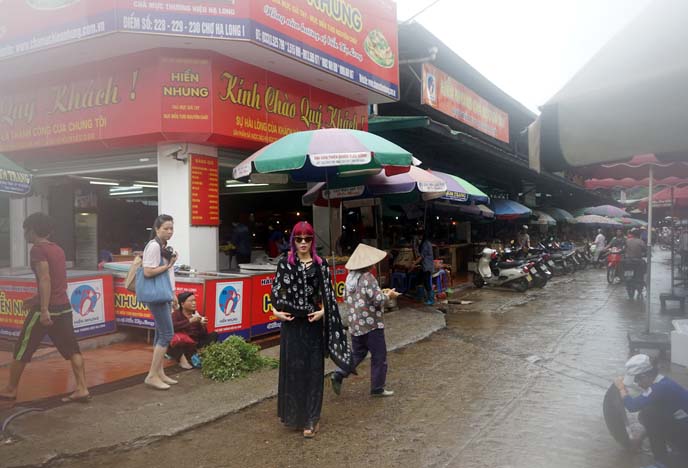
No Instagram filters needed, when you’re traveling in Ha Long Bay. The humidity naturally gives you a blurred vignette effect.
Vietnam remains one of my favorite destinations of 2015. I got to live my dreams of being a Pirate… by taking a boat trip through Halong Bay, with Vietnam Food Tour!
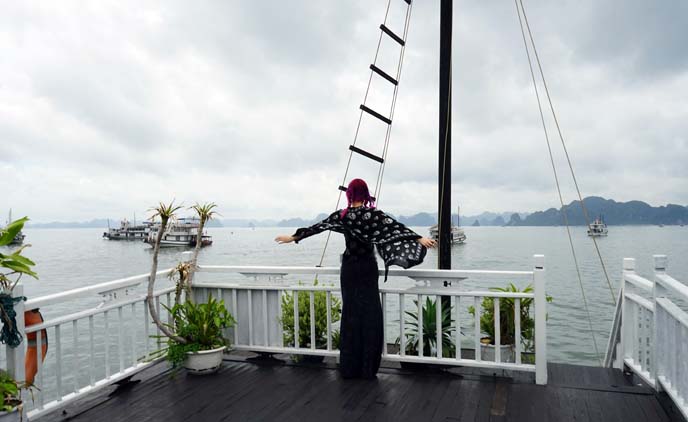
We had our very own private ship, thanks to Hoa Binh Cruises. Keep on reading to see how we climbed the mast, dined on seafood, and drifed through Vietnam’s misty mountains.
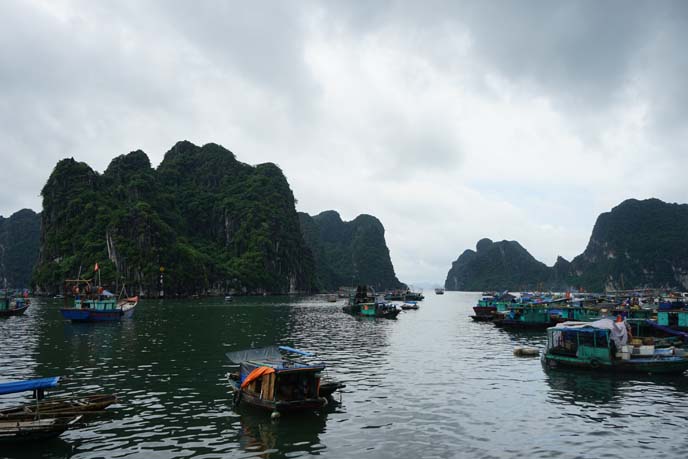
I’m sure you have seen photos of Ha Long Bay before. This UNESCO World Heritage Site is famous for its green, funny-shaped islands.
The name Halong translates to “descending dragon bay” because legend says it was created by a charging dragon.
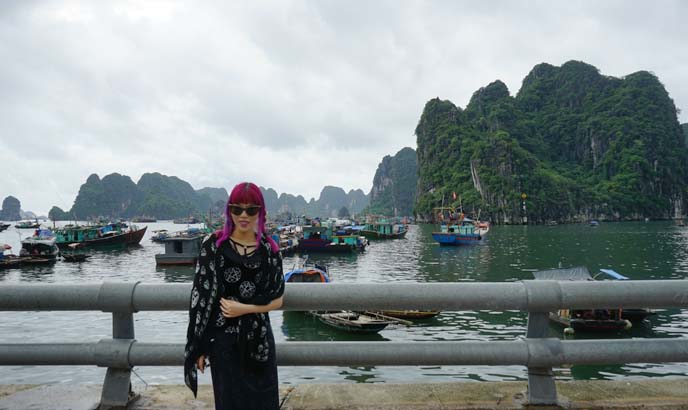
My tank top with silver pentagram symbols is by Rat Baby Clothing — get it here! I paired it with a skull scarf.
Shop more Gothic fashion by clicking below:
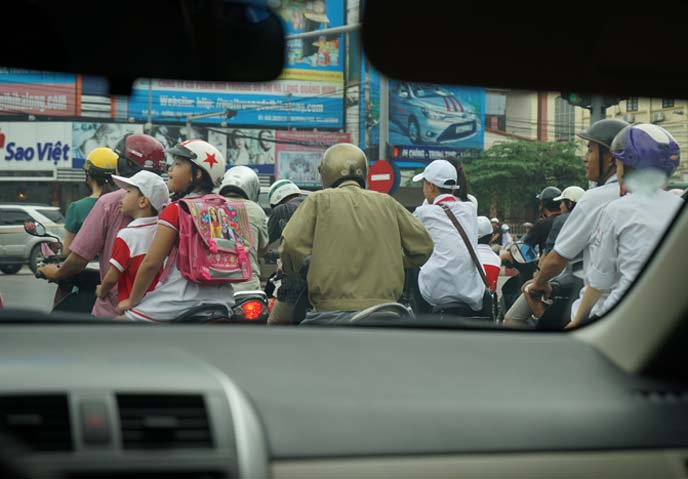
If you’re in Hanoi, going east to Halong Bay is a must (it’s a 3-4 hour drive away).
We recommend hiring a reputable driver and guide, as we did with Vietnam Food Tour. They arranged everything for us — the car, hotel, boat tour, activities. It’s absolutely worth it. We could sit back and soak everything in, without having to haggle or stress about logistics.
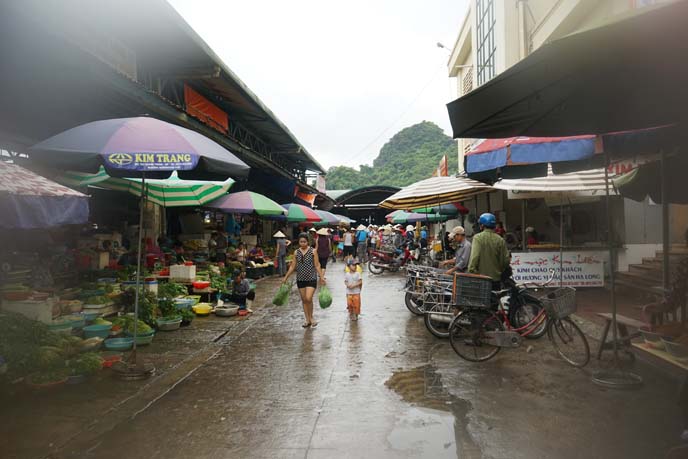
Since we were on a food-centric tour, we began by visiting the local outdoor market. Like on our Hanoi tour, we saw vendors selling all sorts of fresh seafood that came straight out of Halong’s waters.
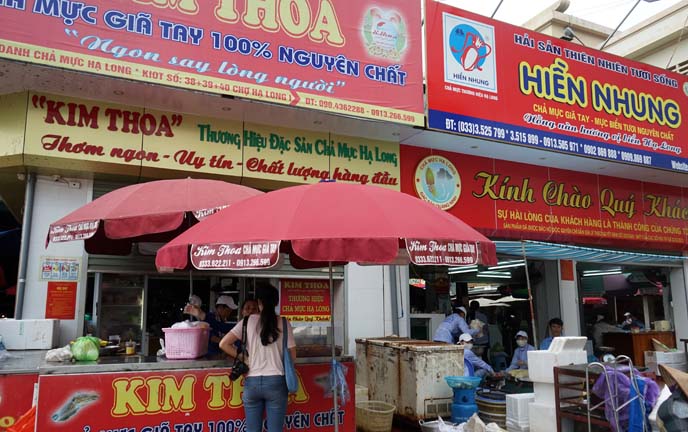
A colorful group of vendors. Our guide, Bao, told us about the special squid pie sold here. She picked up a few specialties for us to try during our cooking boat cruise.
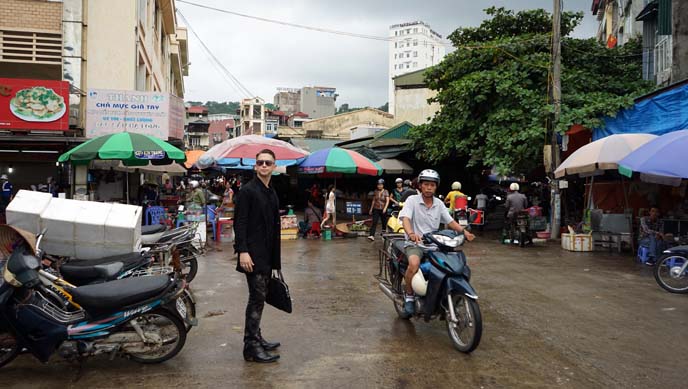
Motorcycles zipped around us, as we took in all the colors and action.
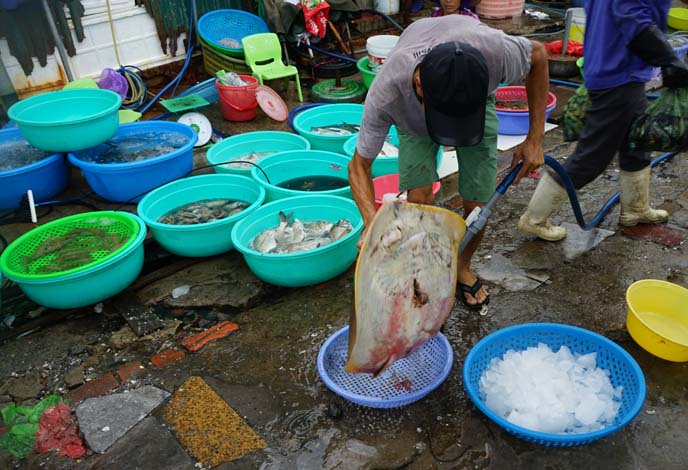
The wet market section was full of live oddities from the sea. Locals come here to pick up the catch of the day.
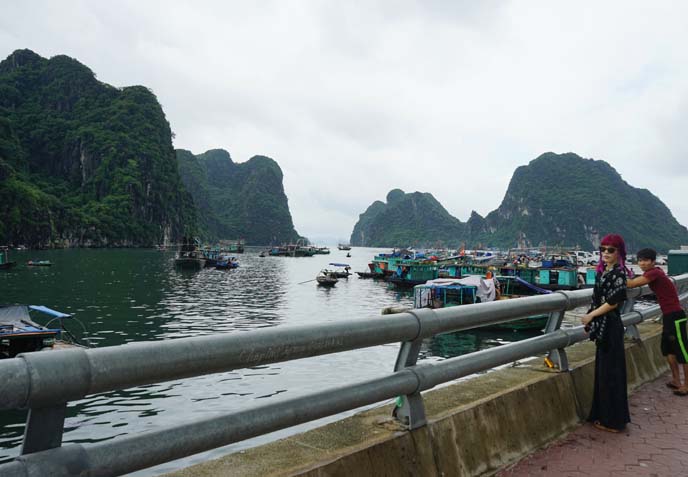
This view is even more majestic in person. Ha Long Bay is dotted with thousands of limestone islands like these.
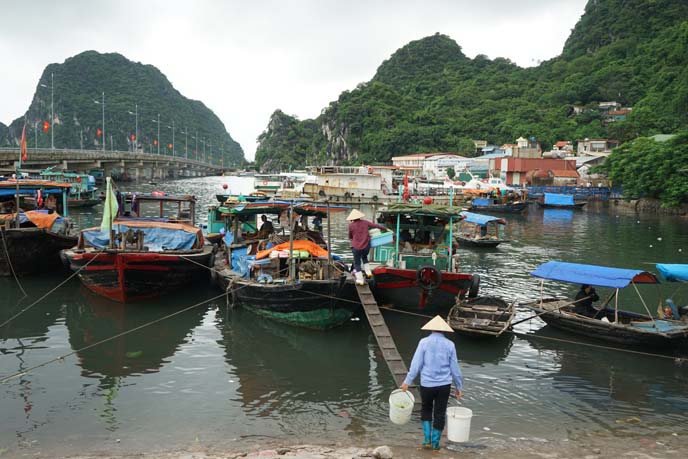
We saw Vietnamese boat people refilling their supplies of water. They live and work in these floating homes.
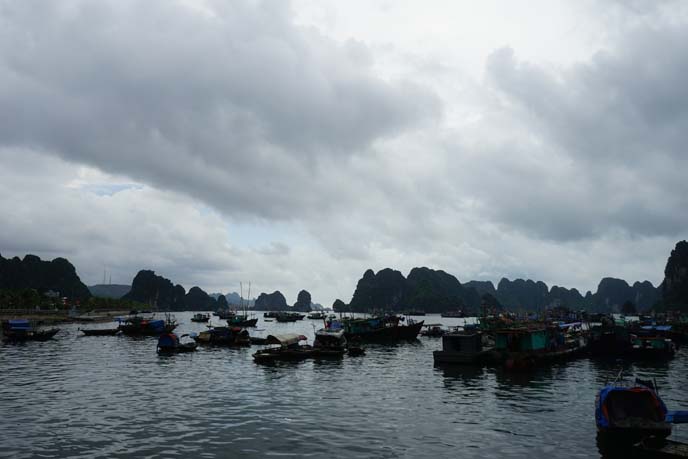
We learned that according to another legend, a family of dragons spat out jewels, which formed these islets and protected Vietnam from invaders.
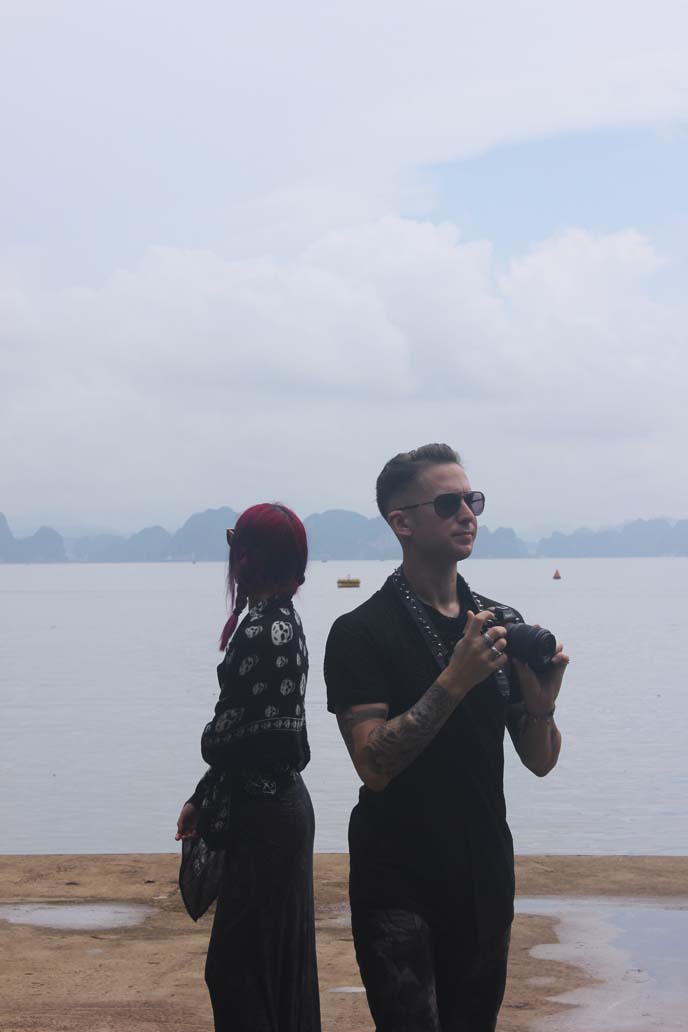
My mate John Skeleton and I took photos non-stop — Ha Long Bay is the definition of photogenic!
(This skull print scarf protected me from the mosquitoes.)
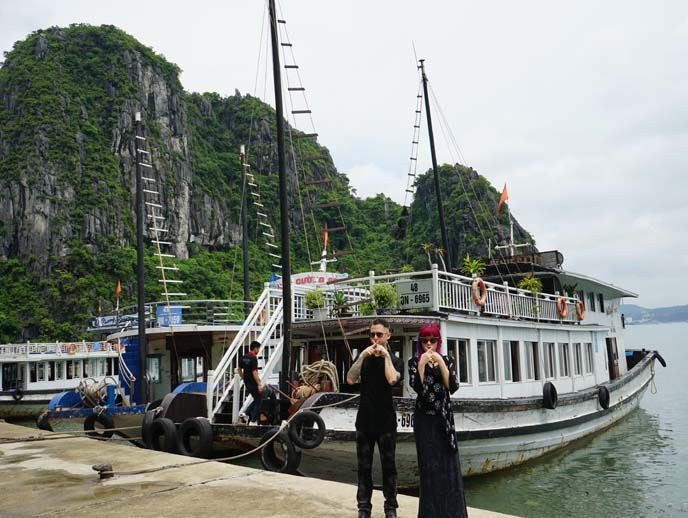
We were looking forward to the boat tour of the bay, on a Hoa Binh cruise. However, we were amazed to find… that we had the entire Pirate boat to ourselves!

Vietnam Food Tour is all about custom, personal experiences — so they book their clients on private boat tours. Now that’s the life for a Pirate.

Spreading my arms wide as we sailed, I felt like Captain Carmina. The only other people onboard were Long John Skeleton, our first mate Bao, and a few cabin members who served food and drink. (And actually steered the ship.)

“Yo ho, there be a pirate’s cove of treasure ahead!”
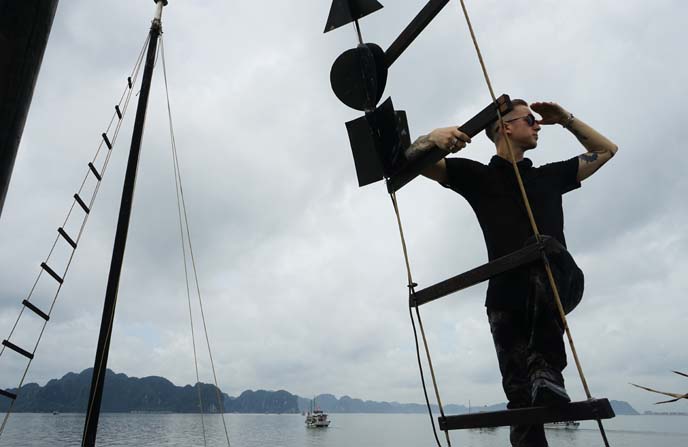
John climbed the mast, all the way to the top — as you can see in our fun travel video!

Before long, our boat was nearing these jewel islands. We prepared for plunder.
(My tank top is by Rat Baby Clothing — more picks below.)
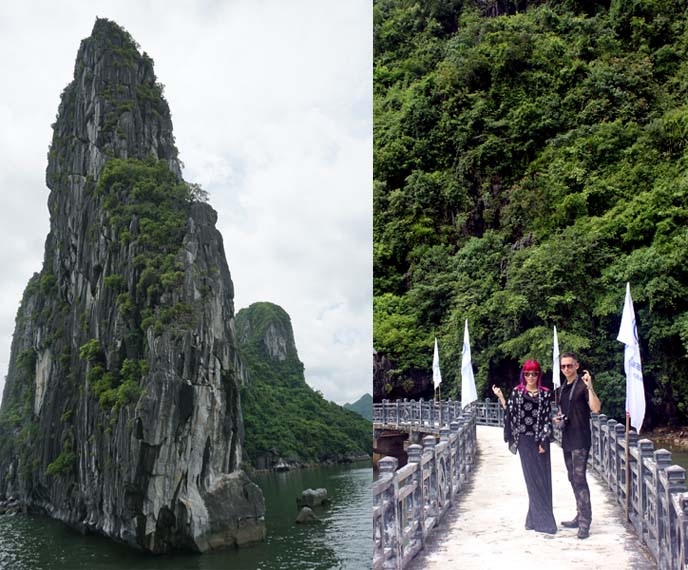
Most of these islands are uninhabited, and lush with tropical vegetation. I imagined them to be hidden with secrets and chests of gold. We docked on Driftwood Island, climbed up the path…

.. and found ourselves in the famous Dau Go Cave (Wooden Stakes Cave).

The humongous grotto is filled with hanging stalactites. The shapes seemed like something from a sci-fi movie, reminding us of bones and Giger’s Alien.

Different parts of the cave are dramatically lit so that visitors can admire the details. Or in this case, “Hail Miffy!”
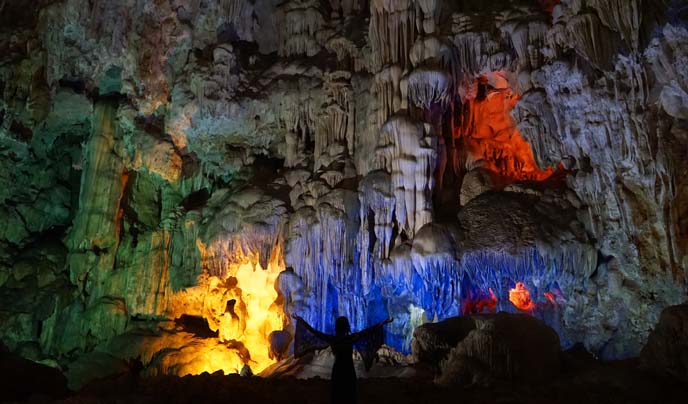
That’s me at the bottom, arms raised. Like a bat in a cave.
My tiny scale of the photo conveys how grand it feels to be inside this grotto, which dates back to the Pleistocene era around 2 million years ago.

Doesn’t this look like the set from an alien horror movie?
Vietnam Food Tour organized our visit so that we came during a less busy hour– so we were able to avoid the tourists.

I flew our flag, upon exiting. I hereby claim these caves for my crew!

A hook for a hand. Arr, there’s nothing like the Pirate’s life.

We continued to explore Halong Bay. Our boating adventure is among my favorite memories of the entire year.

Time to plunder the ship’s seafood. Our crew helped us to grill fresh clams, prawns, sea snails and other delicacies of the ocean.

What a treat, to dine on fresh seafood while taking in these grandiose views of Halong Bay.
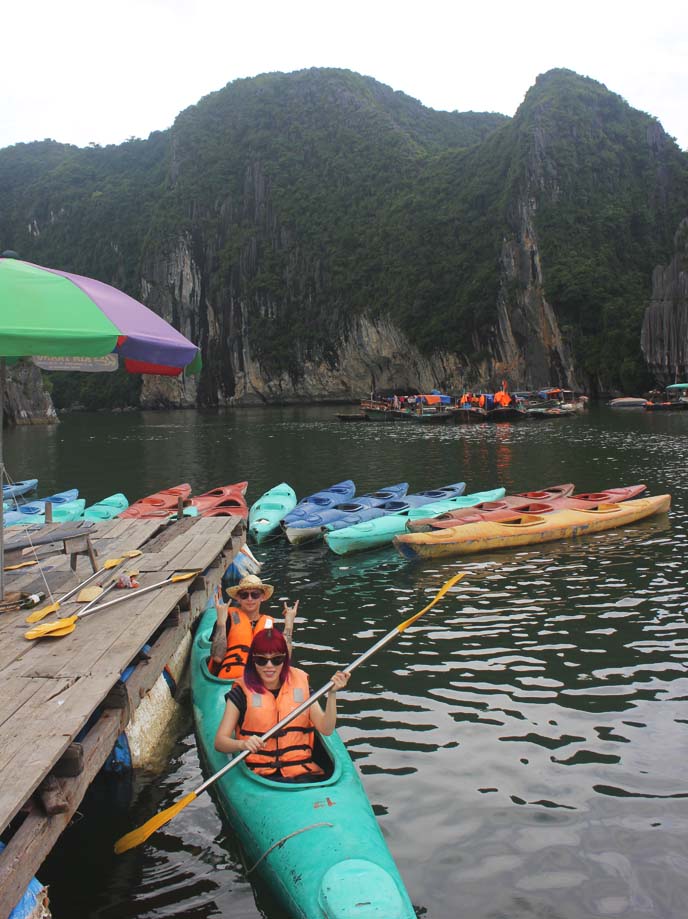
For a closer look at the grottoes, we piled into a kayak.

What can I say? It’s an absolute dream to paddle right up to these mysterious islets, and duck through hidden tunnels that open into lagoons.
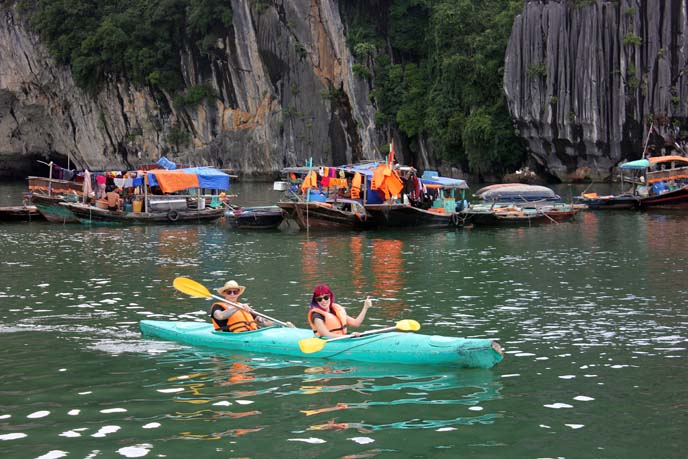
But let’s give credit where it’s due… John did pretty much all of the rowing work!
(Watch our Pirate cooking cruise in action, above and here in this video.)
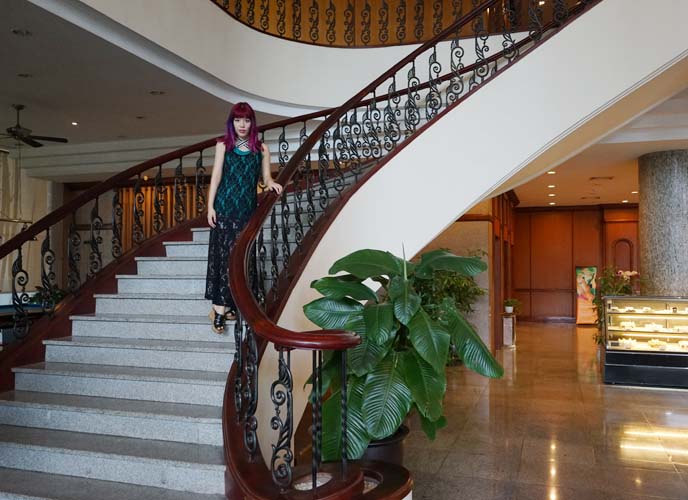
Some visitors choose to stay overnight on a boat cruise. We chose to only do a day tour, and spend the night at the top-rated Halong Plaza Hotel.
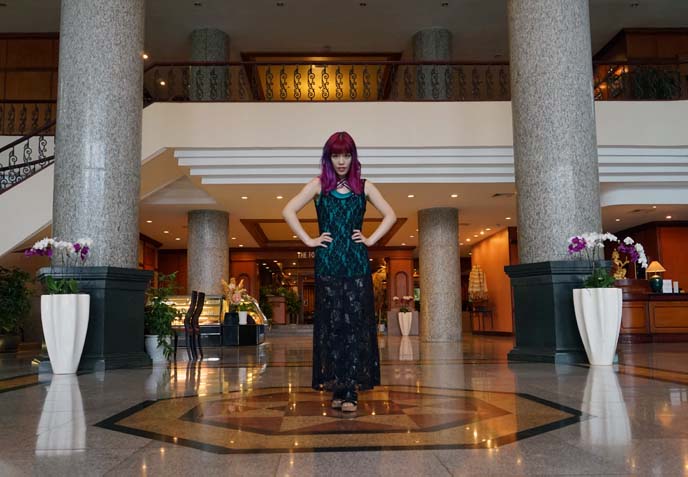
I was glad to sleep on a stable surface, and in a spacious room. We also enjoyed hanging out at the hotel’s lobby bar, which offers a nice selection of cocktails.
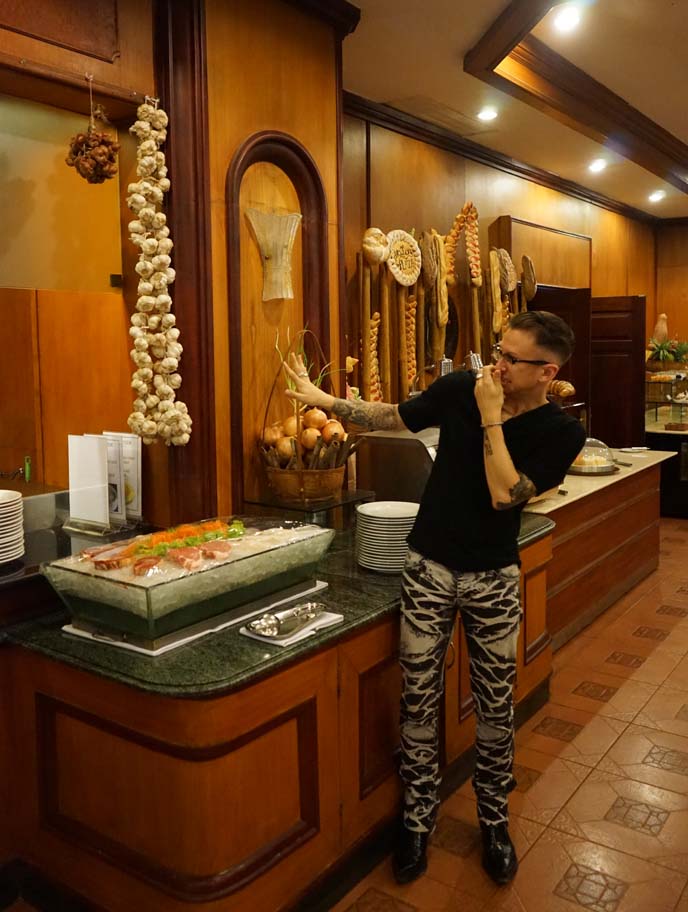
Halong Plaza also had an impressive buffet breakfast, which was included with our stay. I tried the steamed rice noodles, a traditional way to start the day.
The restaurant also hangs garlic to keep vampires away!
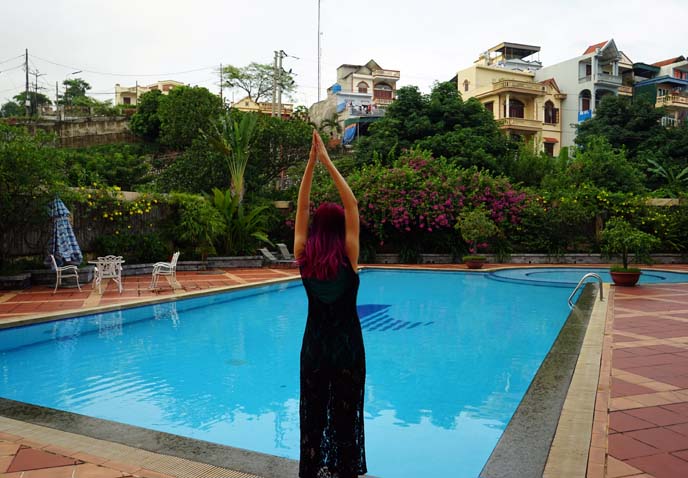
John took a dip in the outdoor swimming pool. The large hotel also has a sauna and gym.
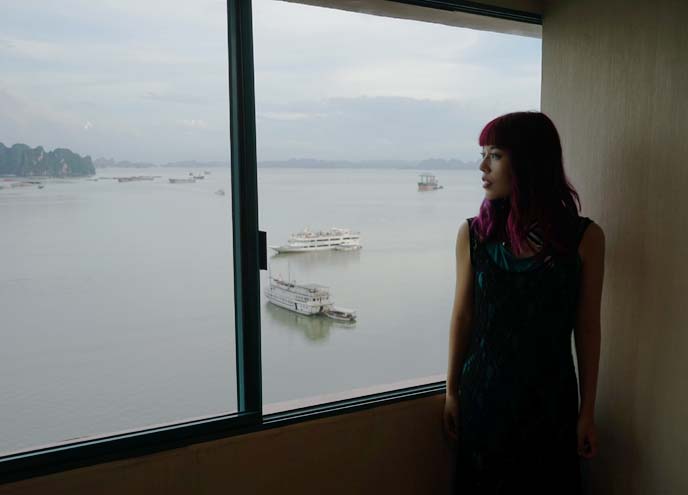
Our room had a magnificent view of the bay and bridge, which lights up with rainbow lights at night.

The manager took us to the rooftop — what a view!
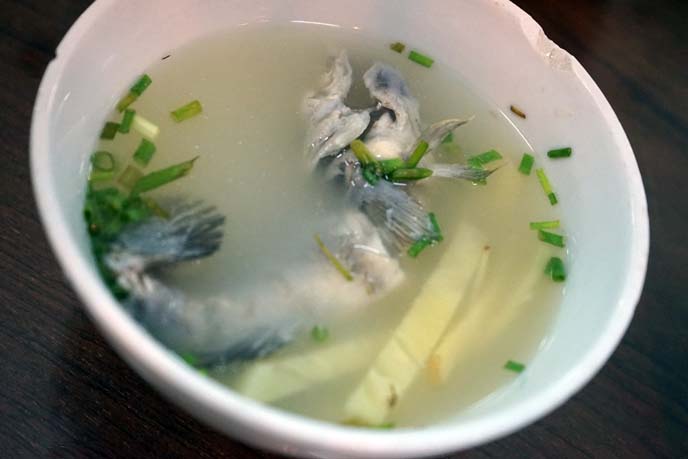
For dinner, our guide took us to a classic seafood restaurant. As always, Vietnamese food was full of fresh, healthy flavors. We had soup with ginger and this small fish found only in Ha Long Bay.
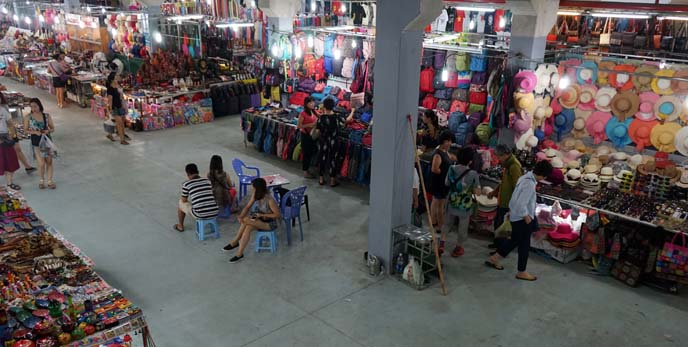
Then, we went to the Halong Bay night market to shop. The night market has a new location, with a modern setup.
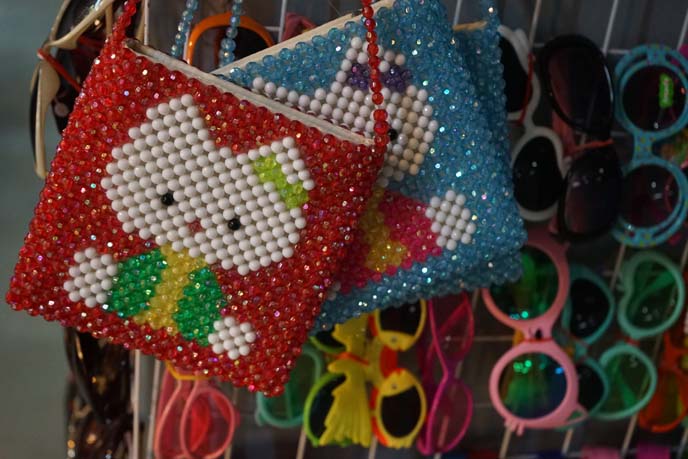
The vendors sell everything from Vietnamese loose tea, to beaded Hello Kitty purses…
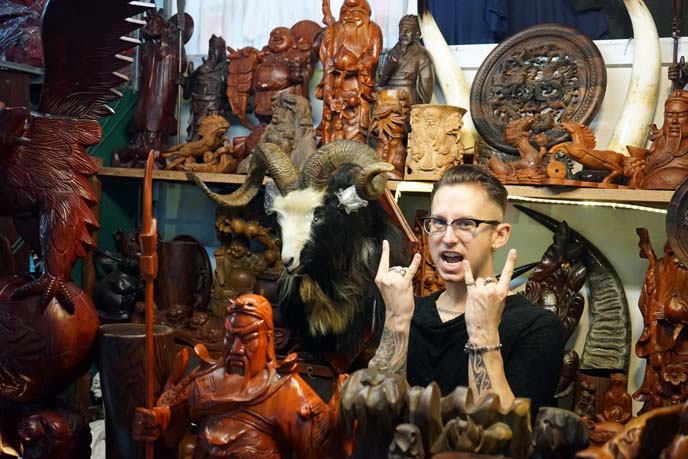
… to a stuffed goat head! Mr Skeleton shows his appreciation for the horned one.
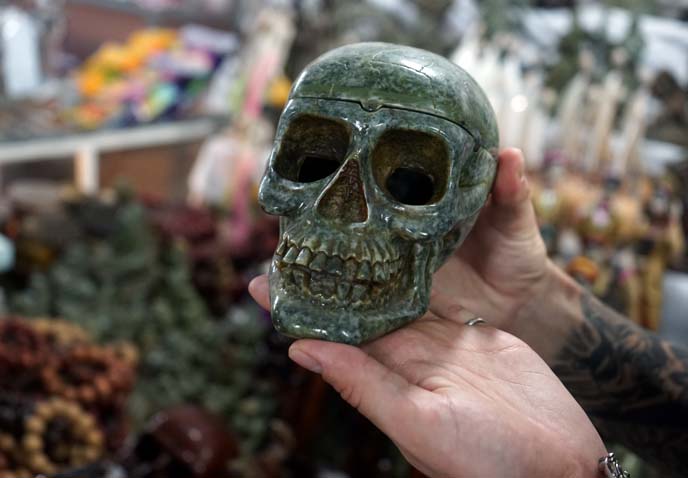
The goat was a bit too large to take home, so he decided on this green skull. Pop the top, and there’s a space to keep treasures.
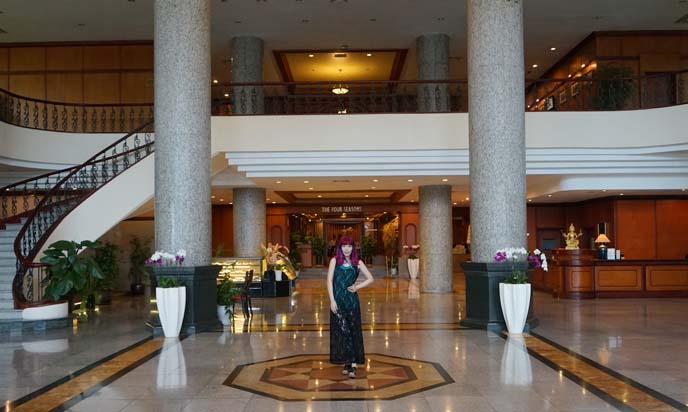
Thanks to Halong Plaza Hotel for the excellent service and big rooms. They’re one of highest rated hotels in Ha Long Bay for a reason.

And of course, to our guides Vietnam Food Tour. Their Savor Vietnam package, which includes sailing around Halong Bay, let us see the best of Northern Vietnam.
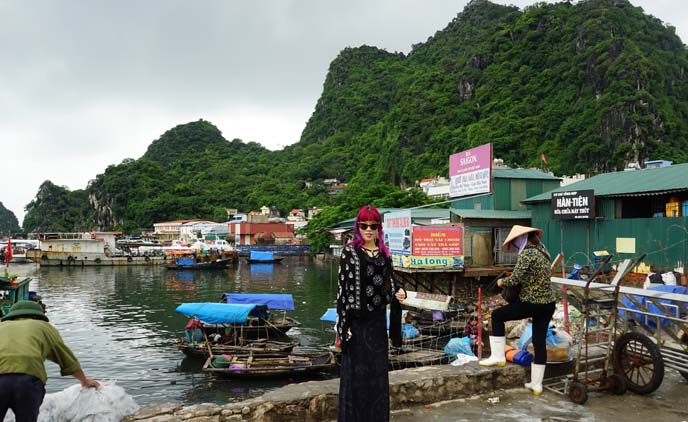
Have my Vietnam travel stories convinced you to come here yet? If you have questions about traveling, or anything at all, please let me know in the comments!

 LA CARMINA
LA CARMINA






